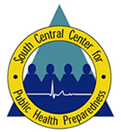
Bioterrorism
Overview
Course Description:
This course will address the nature of Bioterrorism and discuss useful patterns of events, which may suggest that a disease outbreak might be other than spontaneous. The most likely Biological Agents for terrorist use as estimated by the CDC will be individually discussed and specific recommendations made on their identification, outbreak management and patient treatment.
Target Audience
Academic Faculty/Staff, Federal Government Employees, State Government Employees, Local Government Employees, Non-Government Employees and Students
Learning Objectives
- Describe characteristics and results of a biowarfare attack
- Identify characteristics of bioterrorism
- Explain CDC’s Category A list of biological agents
- Identify characteristics of anthrax including signs, symptoms and treatment
- Identify characteristics of smallpox including signs, symptoms and treatment
- Identify characteristics of plague including signs, symptoms and treatment
- Identify characteristics of Tularemia including signs, symptoms and treatment
- Identify characteristics of botulinal toxin including signs, symptoms and treatment
- Identify characteristics of hemorrhagic fever viruses including signs, symptoms and treatment
Faculty
Instructor:

Col. Joseph Contiguglia, MD, MPH&TM, MBA, USAF, MC, CFS
Accreditation
Available Credit
- 3.00 Participation/CETulane Professional and Continuing Education (PaCE) awards 3.00 hour(s) of credit for completing Bioterrorism
Register/Take course
Price
Required Hardware/software
System Settings
This course is designed to work most effectively if your computer and internet connection meet certain minimal requirements. This course can be accessed using a Windows 10 PC or a Mac with High Sierra1, Mojave, or Catalina. Pop-up blockers should be disabled when viewing the course. Internet Explorer 11 (for Windows 10), or the current version of Google Chrome, Mozilla Firefox, or Apple Safari (for Windows 10 and or Mac) is required. Many of our courses require Java and JavaScript enabled.
Links to External Websites
Links to websites outside this course will open in a new window or tab. Some browsers may minimize the course window. If this occurs, maximize the course window to return to the course.
Adobe Acrobat Reader (for desktops and laptops)
Adobe Acrobat Reader is required to access some documents in this course. If you need to download a free copy of Acrobat Reader, click here.
Internet Connection Speed
A minimum download speed of 1.5 Mbps is recommended for an optimal experience, which is commonly the speed associated with a basic DSL or a cellular/satellite connection. A faster connection, such as cable or fiber service, with further enhance your online experience. A Wi-Fi connection is generally acceptable, but it is dependent upon one of the two services mentioned above. You can check your internet connection speed at http://www.speedtest.net/.

 Facebook
Facebook Twitter
Twitter LinkedIn
LinkedIn Forward
Forward